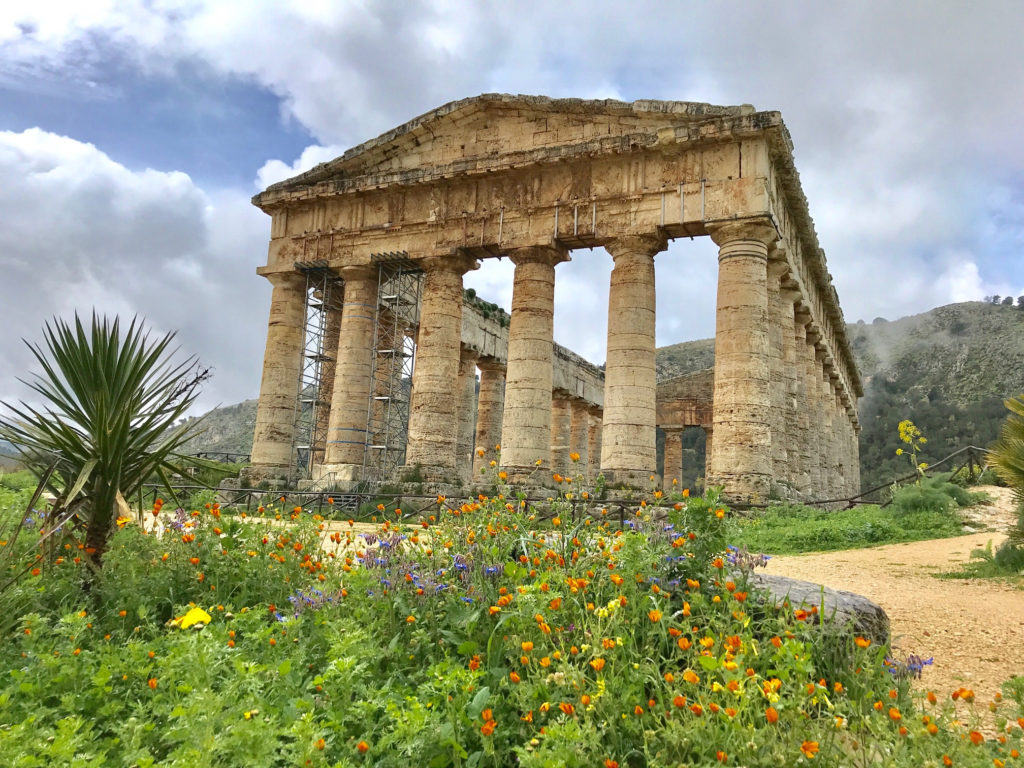
By Patrizia Passerini –
Sicily is a fascinating and mysterious land, with a history and culture of very ancient origins. Its beauty is sometimes wild, amazing and complex due to the overlapping and mixing of cultures that have alternated over the centuries. Rich in history and art, bright colours and intense aromas, it overlooks the Mediterranean Sea, almost to collect the legacy of millennia of civilization. It was considered so fertile to the Greeks that they called it Persephone’s Island, with that fertility goddess highly celebrated there. Even her abdiuction by Hades, god of the Underworld was universally mythologized as happening in Sicily;s Vale of Enna in the center of this island so well known in antiquity for rich soils and wonderful climate. Some visitors like Goethe have believed that Sicily remains the truest epitome of Italy.
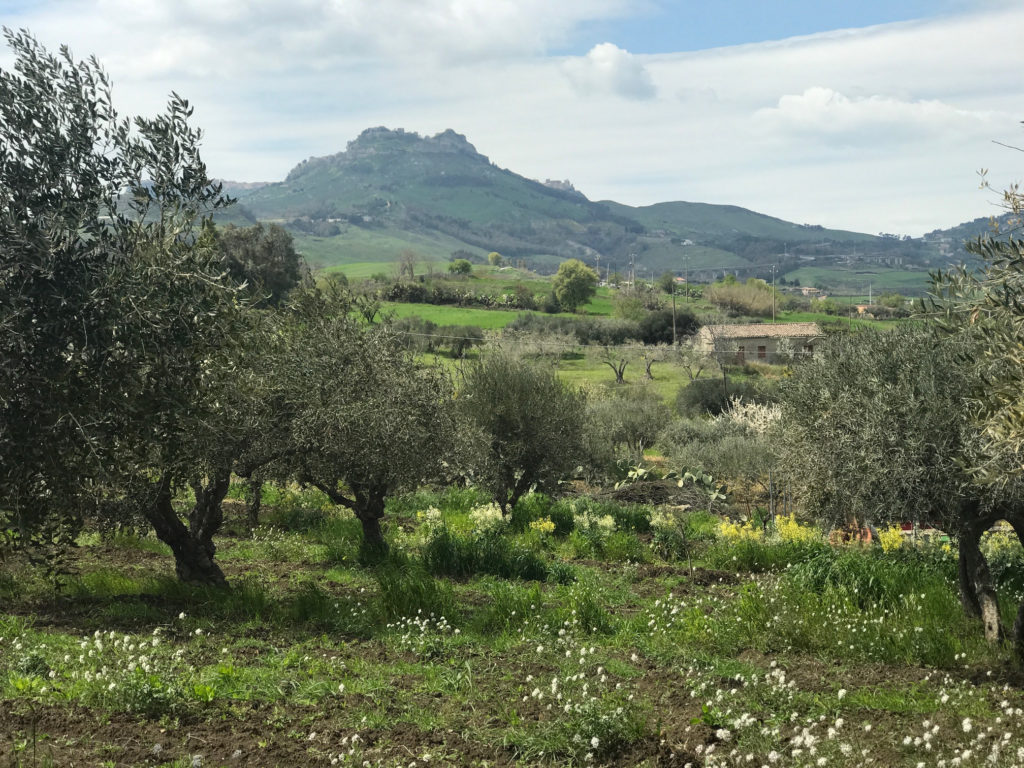
An Ancient History
The origin of viticulture in Sicily is very ancient and recent archaeological research suggests that some kind of wine was produced on the island by Siculi or Sicani peoples even before the arrival of the Phoenicians and the Greeks and even earlier in the Neolithic by possible ancestors of the Sicani and Siculi.
According to a research lead by an international group of scholars coordinated by the University of South Florida and published in 2017 in the scientific journal Microchemical Journal, during an archaeological investigation in the town of Sciacca, near Agrigento, residues of tartaric acid and sodium salts were found in a cave, inside an amphora. These elements are present in the grapes and in the winemaking process and witness wine production dating back to 6000 years ago.
Later the Phoenicians, people of sailors and traders from Lebanon, settled in the western part of the island between the 8th and 7th centuries BCE and founded several towns including Mozia, Marsala (Lilybeo in Phoenician), Trapani (Drepanon in Phoenician), Erice and Segesta, introducing the cultivation of vines.
The Arrival of the Greeks
Soon also the Greeks arrived on the Sicilian coasts and founded their colonies between the 8th and 5th centuries BCE mainly in the eastern part, creating real centers of culture and civilization. Among the most flourishing and rich colonies from an artistic, cultural and commercial point of view, there were Zankle (today’s Messina), Mylae (Milazzo), Naxos (Naxos Gardens), Tauromenion (Taormina), Syrakousai (Siracusa), Katane (Catania), Ghela (Gela), Akragas (Agrigento), Selinus (Selinunte).
The Greek settlers had strong commercial relationships with Greece and often brought with them vine cuttings from the motherland, as they gave enormous cultural and social importance to wine. In this way they introduced in Sicily and in Southern Italy, called “Magna Grecia”, numerous vines still cultivated today, including Moscato, Greco, Falanghina, Aglianico.
The Greeks had developed a set of very advanced knowledge related to the techniques of vine cultivation and winemaking, and they introduced them in the colonies in Sicily. They cultivated the grapevines as saplings, pruned them with various techniques to improve the yield of the plants, and also practiced the varietal selection, innovating the local habit of letting the vines grow spontaneously at the edge of the woods.
Significant is the description that the Greek poet Hesiod (8th c. BCE) makes in his work “Works and Days” of the time of the grape harvest and the methods for making wine, offering a poetic and unforgettable picture:
“When Orion and Sirius have reached the middle of the sky, and the rose-fingered Aurora can see Arturo, then, oh Perse, gather all the bunches of grapes and take them home. Expose them to the sun for ten days and ten nights. Then leave them in the shade for five days, and on the sixth day, pour the gift of Dionysus, rich in joy, into the amphorae”. (Hesiod, Works and Days, 609-617).
Wine was fundamental for celebrating the symposium (which literally means “ritual of drinking together”), the ritual in honor of Dionysus, with a strong symbolic value and deep social meanings. The symposium expressed the celebration of the power and wealth of the aristocracy and created a bond and a sense of belonging among the members of the aristocracy, allowing them to discuss political, philosophical and social issues.
Syracusa and the theater
Syracusa was founded in 734 BCE by a group of settlers from Corinth. During the 5th c. BCE the inhabitants built the amazing theater, situated today inside the Archaeological Park of Neapolis. It was one of the most famous of the antiquity and we know the name of the architect, Damocopo called Myrilla.
The current form possibly dates back to the restructuring conducted under the reign of Ierone II, between 238 and 215 BCE. During his reign, the theater of Taormina was also built, as shown by the engraving of the name “Philistide”, wife of Ierone II, on some steps. It’s located in a splendid panoramic viewpoint from which we can admire the profile of the volcano Etna and the Mediterranean Sea.
The theatre of Siracusa hosted the representation of the tragedies and Aeschylus, the famous Greek tragedian, and the theater presented here for the first time his plays “The Etneas”, then “The Persians”. Aeschylus lived and even died on Sicily near Gela; one ancient anecdote said an eagle flying high overhead accidentally dropped a turtle on his skull which caused his death.
The theater – seating capacity 22,000 spectators, one of the largest in the Greek world – is carved into the rock of the Temenite hill, with the cavea (the space for spectators) facing the sea At the foot of the cavea, there is the Orchestra, the semicircular space where originally stood the altar dedicated to Dionysus, the god whose cult is closely linked to the birth of tragedy in the Greek world.
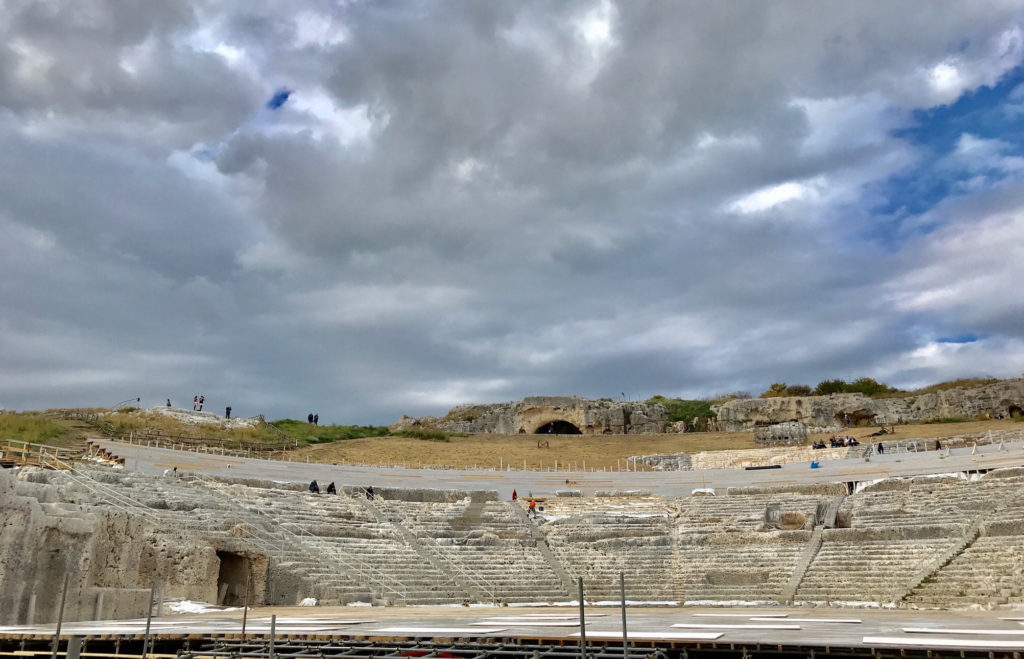
This theatrical genre had as its purpose catharsis and originated from the rites in honor of Dionysus. The term “tragedy” comes from tragus (goat) and ode (song), i.e. “song of the goat”, because sacrificial rites took place in Dionysian ceremonies in honor of the god and they continued to be celebrated at the beginning of the tragedies. The scenic representation of the tragedy was therefore an instrument of symbolic repetition of the sacrificial rite, with cathartic and liberating function.
Among the most famous wines in antiquity there was Moscato, called by the Romans wine from Apianae grapes, or “grapes the bees are fond of”, to highlight the sweetness. Muscat is still cultivated in the eastern and southern part of Sicily, particularly in the areas of Noto and Syracuse. It is an area embraced by the sea and perfumed by the Mediterranean scrub, where the famous Moscato Passito is produced. It comes from grapes left to dry in the sun, so that the water evaporates and there is a strong concentration of sugars and aromas in the berries. This wine is sweet but at the same time fresh, with floral notes and intense fragrances of citrus and candied fruit, soft and harmonious.
The Valley of the Temples in Agrigento
Starting from Syracusa and following the coast south which is marked by a turquoise sea and a series of orange and almond groves, we can arrive at the extreme south-eastern tip of Sicily, Capo Passero, which was a place of raids by Turkish pirates, during the 16th century. North of Siracusa in what was formerly the lovely bay of Augusta, the great 29th c. Sicilian writer Giuseppe Tomaso di Lampedusa most known for his novel il Gattopardo (The Leopard) also staged his lovely mythological tale Il Professore e da Sirena (The Professor and there Siren).
Continuing the itinerary along the crystalline sea, among sandy dunes, small bays and rocky spurs, we reach Agrigento, where the magnificent Valley of the Temples (Valle dei Templi) rises.
“Never in all our life we were given to enjoy such a splendid vision of spring as the one of this morning at the rising of the sun… The gaze sweeps over the great cliff of the ancient city, all gardens and vineyards… towards the southern end of this verdant and flowery plateau you can see the Temple of Concordia rising, while to the east there are the few ruins of the Temple of Juno” (Wolfgang Goethe, Italian Journey, 1816).
The Valley of the Temples rises on a plateau, not far from the sea that can be seen in the distance, and it’s perhaps the most evocative place of the whole island. Wrapped in history and myth, since 1998 it is included by UNESCO in the World Heritage List.
The city of Akgragas (today’s Agrigento) was founded in 580 BCE by Greek settlers from Gela and Rhodes and was defined by Pindar “the most beautiful city among all the ones which house people”. At the beginning of the 6th c. BCE the city was crossed by a great building fervor, as shown by the vestiges of the temples, still visible today, and the city wall, long twelve kilometres that wrapped the whole city, with nine access doors.
In its heyday, the city-state had 200,000 inhabitants and enjoyed great prosperity. In 406 B.C. it was destroyed by the Carthaginians, then in 201 BCE it was conquered by the Romans.
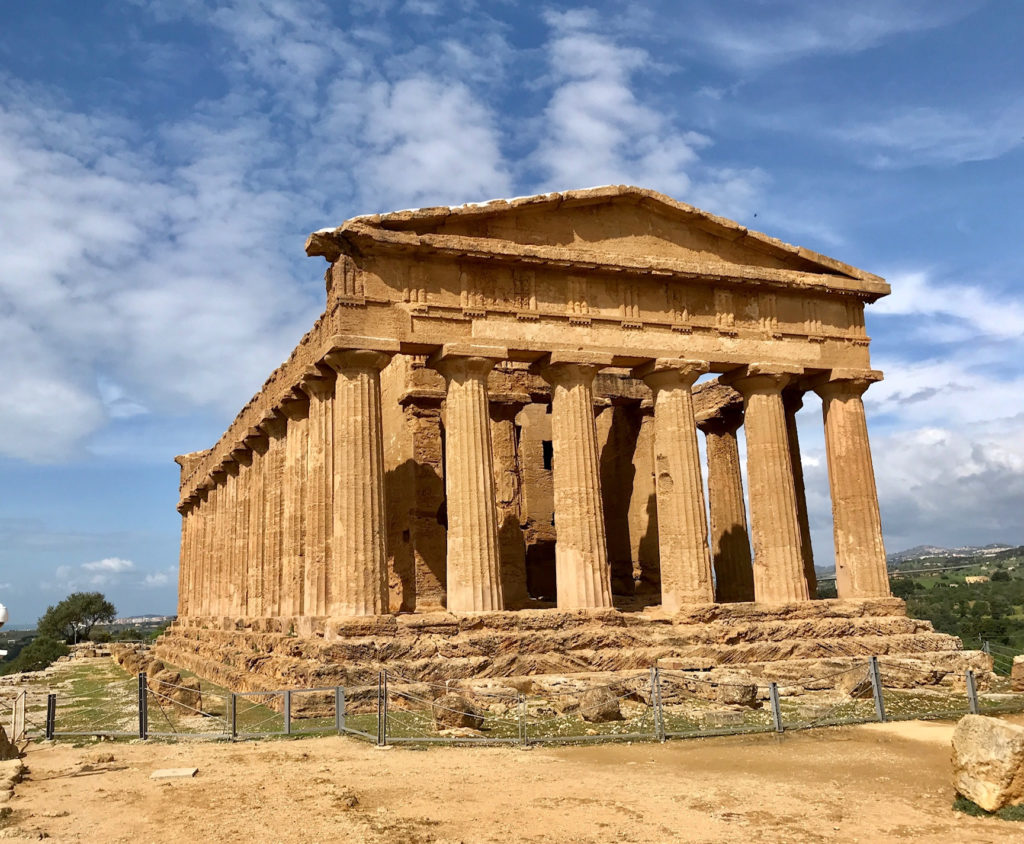
The Temple of Concordia stands on the plateau within the Archaeological Park and it’s one of the best preserved temples of Greek antiquity. The Doric style building dates back to the second half of the fifth century BCE and it completely preserves the elements of the entablature and the two pediments on the east and west sides. During the 6th c. CE it was consecrated as a Christian church, which guaranteed its extraordinary state of preservation. Its name comes from a Latin inscription of the first century CE founded nearby the temple itself and dedicated to the “concordia degli Agrigentini” (The Agrigentines’ harmony).
Moving on the highest rocky spur of the hill, we reach the Temple of Juno, by Doric order and dating back to the fifth century BCE. In addition to these, we can visit the temples of Asclepius, Hercules, Jupiter and two necropolis.
The mighty and magnificent lines of the temples stand in a landscape dominated by olive groves and almond trees, vineyards, citrus fruits and prickly pears, pistachios, carobs and myrtles typical of the Mediterranean scrub.
The presence of the vine and olive tree strongly characterized the Greek landscape and culture. Today the Archaeological Park also aims to the protection and enhancement of the historical landscape of the Valley.
This attention and protection gave as result the realization of the project called Diodoros. Thanks to this project and with the collaboration of high-quality companies in the area, vineyards located between the Temple of Juno, the Temple of Concordia and the remains of ancient Akragas produce a wine called Diodoros, which is the spearhead of the agricultural production of the Archaeological Park.
Marsala and its wine
Continuing the trip and going up the coast towards north-west we reach Marsala, which rises on Cape Boeo (the extreme western tip of Sicily). The city is enveloped by the colours of the surrounding landscape: the yellow of the buildings tuff, the turquoise of the sea, the green of the vineyards and the white of the salt pans of the Stagnone Nature Reserve.
Legendary land in the heart of the Mediterranean, Marsala was founded by the Phoenicians, with the name of Lilybeo and later passed under the domination of the Romans. The town offers a rich archaeological heritage and the Regional Archaeological Museum located there hosts many interesting finds, including many amphorae (which testify to the wealth of wine trade from these coasts to the whole Mediterranean) and the wreck of a Punic ship.
The ship, with its slender line, was shipwrecked in the 3rd century BCE. (probably during the Egadi battle, 241 BCE). It was a rowing ship, 35 meters long and 4.80 meters wide with 68 rowers. The signs of the Phoenician-Punic alphabet engraved and painted on the planking allowed to know the construction technique of the ship by the Punic workers, which were known from classical sources (Polybius, Pliny).
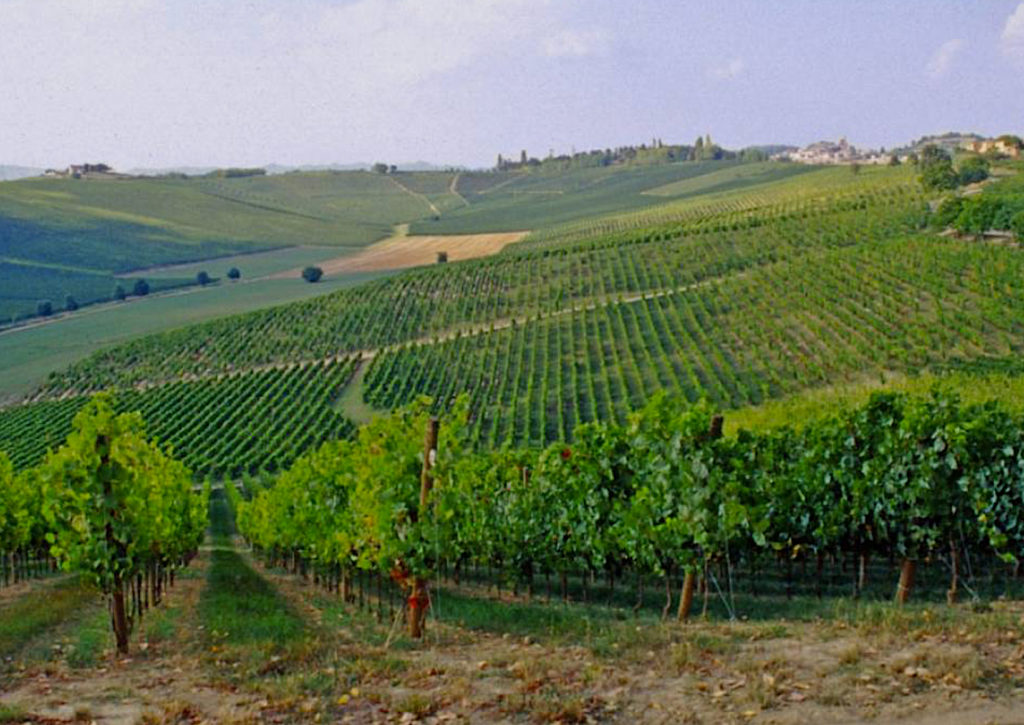
Marsala offers also a rich artistic heritage, which is expression of the dominations and cultural influences that took turns in the following centuries, including the Arabs, the Normans, the Swabians, the Angevins, the Spanish.
The town became starring in the history of wine in 1773: the English merchant John Woodhouse, from Liverpool, during a shipwreck landed in Marsala. In a tavern close to the harbor he tasted the local wine and appreciated it very much. It was a wine similar in taste to the famous Sherry (produced in Jerez, Spain) and Port (produced in Portugal), which were highly fashionable in the Anglo-Saxon world. The method used was called Perpetuum, similar to the Spanish Solera method. It was based on the aging of wine in overlapping chronological barrels (topping up the barrels containing the wine consumed during the year with new wine, so as to preserve its characteristics).
John Woodhouse thought to start marketing it, hoping to have luck. And this is how it went. He took a few barrels of wine, added brandy to increase the alcohol content to preserve it during transport over the sea and he proposed this wine to the British market. The success was so great that Woodhouse came back to Sicily to start producing himself and marketing the wine, followed by other English entrepreneurs, including Ingram and Whitaker.
Given the excellent results, in 1833 even the entrepreneur Vincenzo Florio began to produce Marsala wine and sell it on the market, in competition with the English, founding the Florio Wineries. After the first difficult years, thanks to the quality of his wine and a fleet of merchant ships owned by the Florio family, Marsala wine arrived in many countries and the success was enormous.
It was the first Italian wine to have worldwide resonance. During the 1800s and 1900s in that territory more than two hundred bagli (wineries) were founded, exporting Marsala all over the world and making the ancient Lilybeo very rich and flourishing.
In passing years, Marsala suffered ups and downs. To protect the originality and the production area, in 1969 it was awarded by the designation “Marsala DOC” (the first Sicilian wine to receive the recognition of the DOC).
Marsala is located in the so-called “sun belt” (situated between 32° and 41° parallel in north latitude), which is in the same area where Sherry and Port are born, characterized by strong sunshine, which favors the production of wines of high alcohol content. The soils in Marsala are characterized by the high presence of iron (the famous “red earths”). They are poor in organic substances and are permeable, stony and pebbly. This means that the plant tends to accumulate sugar and does not disperse energy in excessive vegetative development. The vines are mostly grown as saplings and the cultivated vines are Grillo, Catarratto, Ansonica (for Marsala Oro and Ambra), and Perricone, Nero d’Avola, Nerello Mascalese (for Marsala Rubino). An interesting side note is that there are at least about 18 different types of olives grown on Sicily as well. The red wine Nero d’Avola may be the currently known as the signature wine of Sicily.
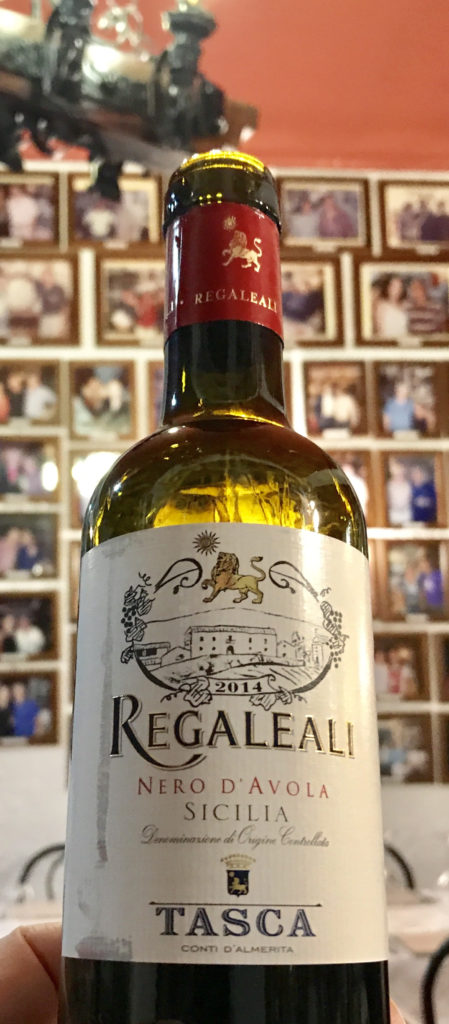
Marsala is a liqueur wine: during fermentation, frequent decanting promotes oxidation. At the end of fermentation, alcohol, wine spirit and cooked must are added, depending on the type, then aging starts. According to the sugar content, it is distinguished in Sweet, Semi-dry or Dry. The types follow the Soleras method and differ according to the years of aging: Fine (1 year), Superiore (2 years), Superiore Riserva (4 years), Vergine or Soleras (5 years), Vergine Stravecchio (10 years).
Florio Wineries can be visited today and offer their visitors an itinerary that points out the stages in the history of the Florio family and an unforgettable sensory experience. The visit starts stopping in front of giant vats built at the end of 1800 and goes on through three fascinating barrels. Then we arrive at the modern Tasting Halls, where it is possible to discover Florio wines matching Sicilian gastronomic specialties, to live an evocative experience. You will appreciate the warm and sweet notes of hazelnut, dried fruit and spices, the hints of licorice, aniseed, cinnamon, the hints of caramel, honey and candied fruit.
According to the type, Marsala can be an excellent aperitif wine – it can go with a gourmet dinner or it can be a perfect meditation wine. For a wine with a great history, it’s best to explore on one’s own and find out some its gustatory secrets.
Last but not least the rich volcanic soils surrounding Mt. Etna are producing wonderful red wines, already highly esteemed for their power and longevity. One such Etna wine is the Tenuta delle Terre Nere, literally alluding to the black earth of the volcano that has been so memorable in Sicilian life for millennia and continues to smoke and even flow with lava today. This volcanic mountain may be one of Sicily’s most prominent landmarks and some of the most memorable views of it are from Taormina near the Greco-Roman theater whose layout highlighted it and the curving Ionian coast. Goethe famously said that from the top of the Taormina theater seats one could see the most beautiful vista in the world.
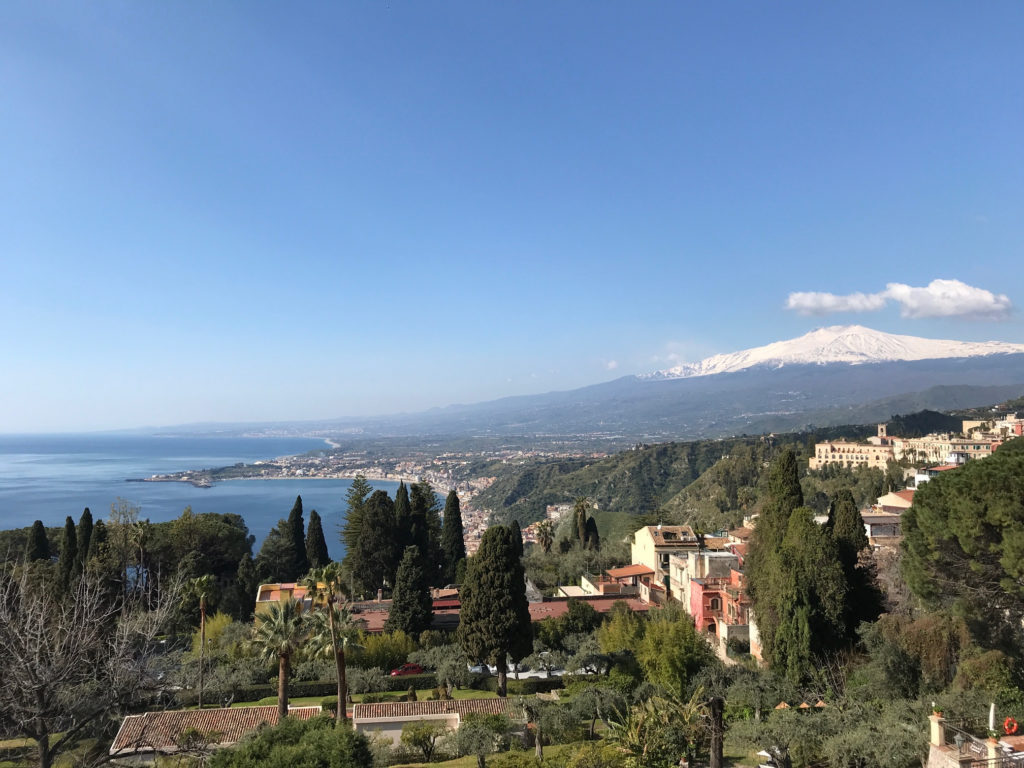
Notes:
[1] J. J. Norwick, Breve storia della Sicilia; Sellerio editore Palermo, 2018
[2] M. Miceli, Siracusa e le meraviglie dell’Unesco, edizioni Edessae, 2008.
[3] E. Cicala, M. Ala, Paesaggio, arte e natura nella Valle dei Templi di Agrigento, edizioni Sikana Progetti d’Arte, 2020.
[4] R. Giuffrida, R. Lentini, L’età dei Florio, Sellerio editore Palermo, 2019
[5] V. Lo Jacono, La storia del Marsala. Dai mercanti inglesi ad oggi, Spazio Cultura edizioni, Palermo, 2020.